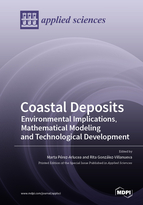Coastal Deposits: Environmental Implications, Mathematical Modeling and Technological Development
A special issue of Applied Sciences (ISSN 2076-3417). This special issue belongs to the section "Earth Sciences".
Deadline for manuscript submissions: closed (31 August 2020) | Viewed by 28059
Related Special Issue: Coastal Deposits: Techniques, Modelling and Implications for Environmental Management
Special Issue Editors
Interests: coastal environments; shore processes; sediment architecture and geomorphology; deep marine environment (slope and basin deposits and processes)
Special Issues, Collections and Topics in MDPI journals
Interests: sand barriers and dunes: processes, sediment architecture, and geomorphology; coastal lagoons: evolution and hydrodynamics; remote sensing for coastal monitoring
Special Issues, Collections and Topics in MDPI journals
Special Issue Information
Dear Colleagues,
The understanding of coastal environments is reaching high importance, as the use of the coastline has been predominant in the last decades. Anthropogenic impact is progressively deteriorating these settings due chiefly to building and infrastructure construction, and many other applications, such as fisheries, transport, and touristic activities. To protect the coast, an extensive knowledge of how nature interacts with the human processes is more and more necessary.
This Special Issue on "Coastal Deposits: Environmental Implications, Mathematical Modeling, and Technological Development" aims to collect high-quality, innovative research papers dealing with many scientific aspects regarding the coast, including sedimentation, 3D-architecture, facies distribution, and related processes, mathematical modeling and innovative techniques in the study and preservation of the coastline. Multi-disciplinary studies, including dynamics, morphology interactions, and coastal protection techniques are welcome.
New approaches and innovative methods leading to understand and protect the coast from erosion due to the incoming, frequent high-energy events, coupled with SLR are of high interest. Other sources of disruption are modifications of the coast due to different installations (breakwaters, recreational ports, harbors, and others) on the shore and adjacent environments. The use of mathematical models could be advantageous to produce simulations which could help to understand or predict modifications in sediment patterns and shore morphology. Another aspect of interest is coastal monitoring through a series of techniques including coastal watch camera installations, web-cameras, remote sensing (SAR, LANDSAT, Sentinel images), air-borne LIDAR, and UAV (unmanned aerial vehicle) data, amongst others.
Prof. Marta Pérez Arlucea
Dr. Rita González-Villanueva
Guest Editors
Manuscript Submission Information
Manuscripts should be submitted online at www.mdpi.com by registering and logging in to this website. Once you are registered, click here to go to the submission form. Manuscripts can be submitted until the deadline. All submissions that pass pre-check are peer-reviewed. Accepted papers will be published continuously in the journal (as soon as accepted) and will be listed together on the special issue website. Research articles, review articles as well as short communications are invited. For planned papers, a title and short abstract (about 100 words) can be sent to the Editorial Office for announcement on this website.
Submitted manuscripts should not have been published previously, nor be under consideration for publication elsewhere (except conference proceedings papers). All manuscripts are thoroughly refereed through a single-blind peer-review process. A guide for authors and other relevant information for submission of manuscripts is available on the Instructions for Authors page. Applied Sciences is an international peer-reviewed open access semimonthly journal published by MDPI.
Please visit the Instructions for Authors page before submitting a manuscript. The Article Processing Charge (APC) for publication in this open access journal is 2400 CHF (Swiss Francs). Submitted papers should be well formatted and use good English. Authors may use MDPI's English editing service prior to publication or during author revisions.
Keywords
- Coastal environments
- Coastal erosion/sedimentation
- Remote sensing
- Coastal watch techniques
- Coastal protection and implications
- Mathematical models
- Coastal management
- Coastal monitoring techniques and tools







